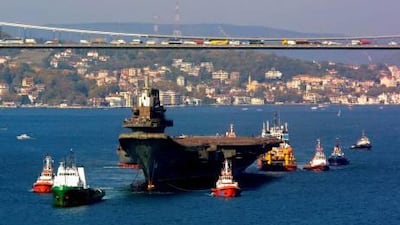BEIJING // China's first aircraft carrier has left port for its inaugural sea trials amid official assurances the world has "no need to be unsettled" over the vessel.
The carrier sailed from Dalian in Liaoning province yesterday morning, almost a decade after the Soviet-era vessel was bought as an empty shell from Ukraine.
China's official media has played down the significance of the country becoming the world's 10th nation to have a carrier, saying the ship would be used as "a platform for research, experiment and training".
In a commentary yesterday, the official Xinhua news agency said "aircraft carriers will not change the Chinese navy's strategic deployment, nor the country's defensive national defence policy, and thus should not be viewed as a threat".
Last month the state-run China Daily newspaper even branded the 300-metre vessel, launched in 1988 but never operational for the Soviet Union that built it, "obsolete".
Yet Richard Bitzinger, a defence analyst at Singapore's S Rajaratnam School of International Studies and editor of the book The Modern Defence Industry, said if the carrier really was obsolete, China would not be spending "time and a lot of money on it".
"This [carrier] is indicative of a long-term strategic plan by the Chinese to develop a blue-water navy for their power projection," he said.
"If you listen to what they're saying, 'we need at least three or maybe five aircraft carriers', their intentions are pretty surprising.
"I don't like to use the word alarming, but kind of moving in that direction, where I would be very concerned about an increasingly aggressive or even provocative PLA [People's Liberation Army] navy."
Reports suggest China is building another carrier from scratch for launch in several years' time.
According to Xinhua, the length of the aircraft carrier's first trial is unknown, although the local maritime authority has warned vessels to keep out of a stretch of water in the area until Sunday.
The trials come just two months after China first acknowledged the vessel's existence, although it has been reported on and photographed since last year.
The ship's name has been changed from the Varyag to the Shi Lang.
China's official defence budget has increased by double-digit amounts every year for the past two decades, except last year, and this year rose 12.5 per cent to 601 billion yuan (Dh344bn).
Mr Bitzinger said China was "still trying to figure out how to operate a large ship" such as its refurbished carrier and so the vessel would have "negligible short-term effect" in relation to US regional military power. He suggested it would take at least five years to get the carrier and its aircraft fully operational.
Yet, with China having multiple maritime territorial disputes with neighbours, particularly in the South China Sea, Mr Bitzinger said the vessel could later become significant in projecting military power in the region. He noted Vietnam had already reacted by buying Russian submarines. "If you're trying to project ... 10 or 15 years, you will probably find in Indonesia or Malaysia a new-found appreciation for naval warfare capabilities. You might see them buying more frigates or corvettes or more submarines," he said.
Yu Wanli, an associate professor in Peking University's School of International Studies, said neighbours such as Japan, Vietnam and the Philippines, which have territorial disputes with China, "will really feel a threat from this ship".
"This situation will push these countries closer to the United States," he said.
He suggested Vietnam and the Philippines, which have both recently had spats with China over the South China Sea, would be particularly concerned.
"These dispute countries will find they're losing their opportunity to make compromises with China. That's why they're in a hurry to provoke, to take proactive action, because they know time is not on their side," he said.


